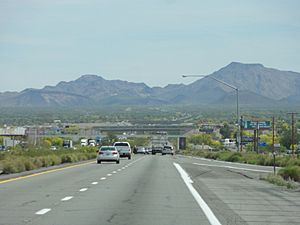Plomosa Mountains facts for kids
Quick facts for kids Plomosa Mountains |
|
|---|---|

section of west flank of Plomosa Mountains
(as viewed from Quartzsite, Arizona on Interstate 10 in Arizona) (high resolution expandable photo) |
|
| Highest point | |
| Peak | Black Mesa (Plomosa Mountains) |
| Elevation | 3,639 ft (1,109 m) |
| Dimensions | |
| Length | 25 mi (40 km) N-S |
| Width | 6 mi (9.7 km) |
| Geography | |
| Country | United States |
| State | Arizona |
| Borders on | La Posa Plain and the Dome Rock Mountainsto the West New Water Mountains to the SE |
The Plomosa Mountains are a mountain range located in La Paz County, Arizona. They are found in the southwestern part of the state, close to the border with California. These mountains stretch south from the town of Bouse, Arizona. To their west, you'll find the town of Quartzsite across a flat area called the La Posa Plain. Other mountain ranges like the Harcuvar Mountains and Little Harquahala Mountains are to the east, separated by the Ranegras Plain. The New Water Mountains are to the southeast, past a high point called Black Mesa.
Contents
Exploring the Plomosa Mountains
The Plomosa Mountains are a long, narrow range. They stretch about 25 miles (40 km) from north to south. At their widest point, they are about 6 miles (10 km) across.
Roads and Towns
Interstate 10, a major highway, crosses right through the middle of the Plomosa Mountains. This makes them easy to see when driving through Arizona. On the southwest side of the range, you can find the site of a former mining camp and ghost town, also named Plomosa. A ghost town is a place where people used to live and work, but now it's mostly empty.
Mountain Peaks
The highest point in the Plomosa Mountains is a peak called Black Mesa (La Paz County). It is located in the southern part of the range. Another important high point is Ibex Peak, which is found in the northern section of the mountains.
How the Mountains Were Formed
Scientists who study rocks and the Earth's surface, called geologists, have found interesting things about the Plomosa Mountains. They see evidence of different types of "faulting" here. Faulting is when large cracks form in the Earth's crust, and the land on either side moves. This movement can push land up or slide it past each other, creating mountains and valleys over millions of years.

